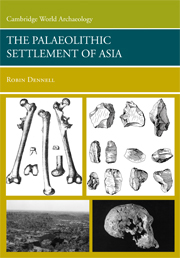Book contents
- Frontmatter
- Contents
- List of Tables, Figures, and Boxes
- Preface
- 1 Asia and Its Place in Palaeoanthropology
- 2 The African Background to the Colonisation of Asia
- 3 The Climatic and Environmental Background to Hominin Settlement in Asia before 1 MA
- 4 The Earliest Inhabitants of Southwest Asia
- 5 The Earliest Inhabitants of South and Southeast Asia and China
- 6 “Out of Africa 1” Reconsidered and the Earliest Colonisation of Asia
- 7 The Climatic and Environmental Background to Hominin Settlement in Asia between ca. 1 Ma and the Last Interglacial
- 8 The Middle Pleistocene Archaeological Record for Southwest and Central Asia
- 9 The Middle Pleistocene Archaeological Record of the Indian Subcontinent
- 10 The Middle Pleistocene Archaeological Record of China and Southeast Asia
- 11 Human Evolution in Asia during the Middle Pleistocene
- 12 Concluding Remarks
- Appendix 1 The Sizes of Countries and Regions in Asia, with Comparative Examples
- Appendix 2 Geographical Coordinates of Principal Early Palaeolithic Sites in Asia
- Appendix 3 Geographical Coordinates of Geological Sections and Cores
- Appendix 4 English Names of Various Mammals Recorded in Asia
- Bibliography
- Index
3 - The Climatic and Environmental Background to Hominin Settlement in Asia before 1 MA
Published online by Cambridge University Press: 05 June 2012
- Frontmatter
- Contents
- List of Tables, Figures, and Boxes
- Preface
- 1 Asia and Its Place in Palaeoanthropology
- 2 The African Background to the Colonisation of Asia
- 3 The Climatic and Environmental Background to Hominin Settlement in Asia before 1 MA
- 4 The Earliest Inhabitants of Southwest Asia
- 5 The Earliest Inhabitants of South and Southeast Asia and China
- 6 “Out of Africa 1” Reconsidered and the Earliest Colonisation of Asia
- 7 The Climatic and Environmental Background to Hominin Settlement in Asia between ca. 1 Ma and the Last Interglacial
- 8 The Middle Pleistocene Archaeological Record for Southwest and Central Asia
- 9 The Middle Pleistocene Archaeological Record of the Indian Subcontinent
- 10 The Middle Pleistocene Archaeological Record of China and Southeast Asia
- 11 Human Evolution in Asia during the Middle Pleistocene
- 12 Concluding Remarks
- Appendix 1 The Sizes of Countries and Regions in Asia, with Comparative Examples
- Appendix 2 Geographical Coordinates of Principal Early Palaeolithic Sites in Asia
- Appendix 3 Geographical Coordinates of Geological Sections and Cores
- Appendix 4 English Names of Various Mammals Recorded in Asia
- Bibliography
- Index
Summary
INTRODUCTION
The climate of Asia south of latitudes 40–45°N. (the northern limit of hominins in Asia before the Middle Pleistocene) is dominated by two weather systems. The first affects Southwest and Central Asia, where most precipitation occurs in winter and spring and is transported by westerly winds blowing inland from the Mediterranean, as well as the Black and Caspian Seas. As one proceeds inland from the coast of northern Israel, Lebanon, and western Turkey (where rainfall can reach 1,000 mm), the rainfall totals decrease dramatically, and almost all of the Arabian Peninsula and much of Syria, Iraq, Iran (particularly on the Iranian Plateau), and Central Asia is semidesert or desert, with rainfall as low as <50 mm/yr. Exceptions where rainfall is higher are the Caucasian, Tauros, and Zagros Mountains of the Caucasus region, eastern Turkey, and western Iran and the southern coasts of the Black and Caspian Seas. The second and more important Asian weather system is the monsoon, and fluctuations in its strength and direction have always had major consequences for animal and plant life over much of the continent. Because of the importance of the monsoon, much of this chapter concerns its origins and development.
THE MONSOON
The monsoon is the world's largest weather system, and today profoundly affects some three billion people in China, India, and Southeast Asia.
- Type
- Chapter
- Information
- The Palaeolithic Settlement of Asia , pp. 35 - 81Publisher: Cambridge University PressPrint publication year: 2008

